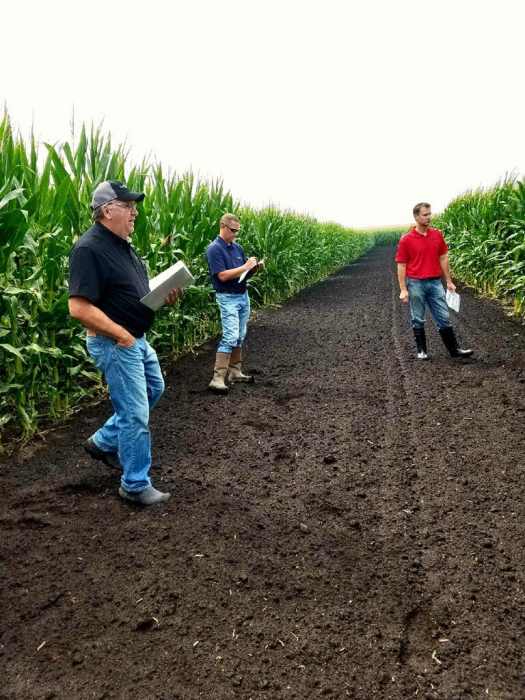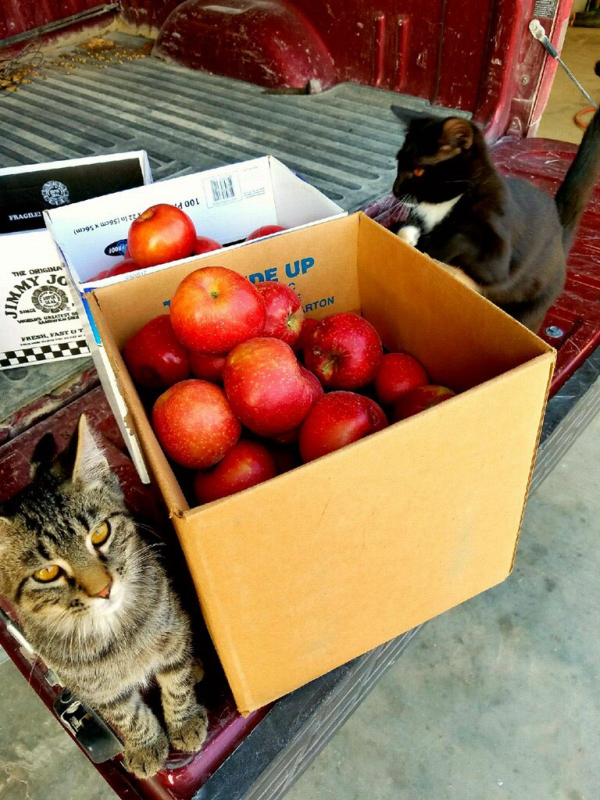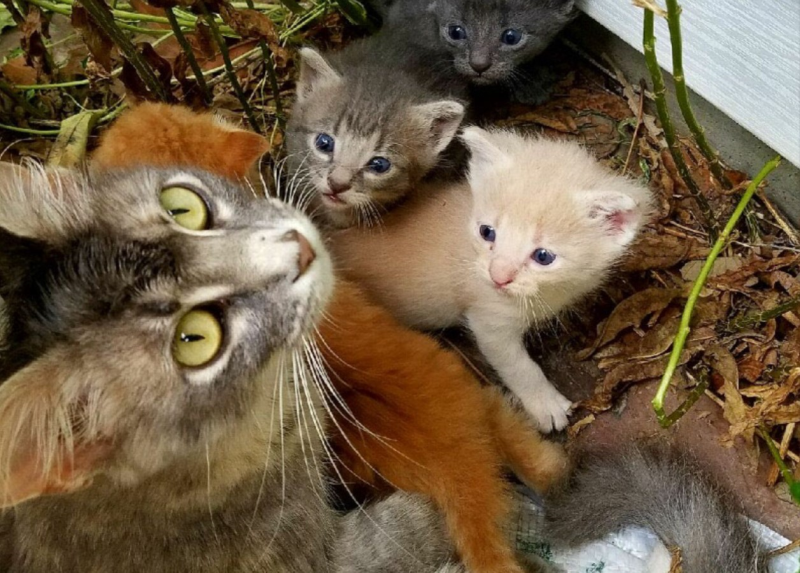Farm Life Journal - September 2017
September 20, 2017
By Mark Jackson
Let the harvest begin
 September brings Labor Day, the unofficial end of summer. This means kids are back in school, there is less than four months till Christmas and yes, football – lots and lots of football. Across the Midwest, September marks the seasonal change of colors as crops transition from Mother Nature’s trade-mark shades of green to the golden-brown colors typical with harvest of our two most dominant crops, corn and soybeans. For the next 60 days, nearly 180 million acres will be transformed from Mother Nature’s marvel of growth to the product of the U.S. farmer’s commitment to excellence and hard work. Soon there will be grain bins full of starch and protein, our source of nutrition for the coming year. Did you know that Iowa will harvest about 14% of the nation’s total with 24 million acres? That’s nearly 75% of our state’s land mass that is devoted to corn and soybean production, which is why Iowa ranks #1 in the U.S.
September brings Labor Day, the unofficial end of summer. This means kids are back in school, there is less than four months till Christmas and yes, football – lots and lots of football. Across the Midwest, September marks the seasonal change of colors as crops transition from Mother Nature’s trade-mark shades of green to the golden-brown colors typical with harvest of our two most dominant crops, corn and soybeans. For the next 60 days, nearly 180 million acres will be transformed from Mother Nature’s marvel of growth to the product of the U.S. farmer’s commitment to excellence and hard work. Soon there will be grain bins full of starch and protein, our source of nutrition for the coming year. Did you know that Iowa will harvest about 14% of the nation’s total with 24 million acres? That’s nearly 75% of our state’s land mass that is devoted to corn and soybean production, which is why Iowa ranks #1 in the U.S.
Dreams without goals are merely dreams, as farmers well know. It was twelve months ago that plans and preparations began for the 2017 crop season. Right now, plot tours are in full swing as farmers are looking for the latest and greatest corn and soybean numbers available for the 2018 growing season. Not unlike looking at the latest new car premiered on the car dealers showroom floor, farmers flock to area field plot tours which feature dozens of their seed dealers’ newest and best seed numbers, not to kick the tires but to check the root scores and yield potential. Corn hybrids and soybean varieties come in all maturity levels, pest resistance, soil type adaption, plant height, size and yield potential with a substantial price tag to match. Some seed varieties cost seed companies hundreds of millions of dollars to research and develop, but gives farmers options that our grandparents never had. In some cases, the options eliminate the need to spray a broad array of insecticides and herbicides, resist severe drought conditions and allow for a higher quality grain at harvest. Farmers can plant what they choose. Conventional and old school seeds are readily available, but the last twenty years have transitioned modern agriculture to a world stage and farmers recognize the value of using new technologies, not only for their bottom line but the environmental benefits as well.
 Field scouting has pretty much been reduced to making yield calculations, a basic process of averages as we try to anticipate the storage bin space needed to contain harvested crop. Various formulas exist; for corn the simplest method is to determine the average number of plants per acre, ears per plant and kernels per ear, then divide by kernel size in a bushel. Do the math and this will give a ballpark yield. A similar process works for soybeans using plant population, but then pods per plant and beans per pod divided by beans in a bushel, using math and the law of averages once again. These yield estimations give the farmer more flexibility in determining available bin space, especially for distant field locations. Grandpa would say, “When time is precious efficiencies draw profits.”
Field scouting has pretty much been reduced to making yield calculations, a basic process of averages as we try to anticipate the storage bin space needed to contain harvested crop. Various formulas exist; for corn the simplest method is to determine the average number of plants per acre, ears per plant and kernels per ear, then divide by kernel size in a bushel. Do the math and this will give a ballpark yield. A similar process works for soybeans using plant population, but then pods per plant and beans per pod divided by beans in a bushel, using math and the law of averages once again. These yield estimations give the farmer more flexibility in determining available bin space, especially for distant field locations. Grandpa would say, “When time is precious efficiencies draw profits.”
The process of adding fall cover crops has already begun for some who apply aerial seeding of cereal rye and various other species into standing corn or soybean fields, but uniform emergence depends on timely rains. I’ve had cereal rye flown on in the past, but have found drilling directly into fresh harvest stubble will have a more uniform stand, especially when the soil surface is as dry it has been. It requires more work when time is already at a premium, but we shuffle priorities and manage to get things done. The drilling process also helps size some of the excess surface residue as the cutters travel at a slight angle to the spring planting. All in all, nearly 1 in 4 Iowa farmers are using cover crops. Nearly 650,000 acres were planted 2017, one more step toward cleaner water and healthier soils.
A to Z
Everything the farmer has been working for during the growing season will soon begin in earnest. Meanwhile in the garden, everything from apples to zucchini continue to bring variety to my table as more items will soon mature. My alphabet of items includes beets, carrots, cucumbers, tomatoes, peaches, pears, pumpkins, gourds and sweet potatoes. What a fun journey to bring family members together, while maintaining our connection to agriculture through a better understanding of the growing season. Of course, with Mother Nature’s participation and our time and efforts spent, in exchange of produce harvested.
In the garden, next to my joy of flowers comes my love of trees and shrubs. “Annuals are grand but perennials are forever,” Grandma liked to say, though she knew the concept was more about optimism than plants alone. Late last fall, powerful straight-line winds took down a century-old maple tree coupled with the ash bore which has taken its toll in my yard as well. My plans are to do a tree planting this fall, which is a favorable time to start young trees. Once again, your Earl May store can bring science and common sense to simplify the process and make for a beautiful yard for years to come.
 Under the watchful eye of Grumpy, the farm shop is overflowing with fall machinery getting last minute checkups and preparations as we ready equipment for the 2017 harvest. Even new harvest equipment needs special attention prior to use, not unlike the process of “setting up” a new cell phone or computer. For example, we have to calibrate a new header – an attachment used to cut or strip, either soybeans or corn and feed the crop into the combine for threshing. Calibration of the header allows the combines on board computer system to recognize its width and distance off the ground, then it will be able to glide along the ground, following the contours of our fields.
Under the watchful eye of Grumpy, the farm shop is overflowing with fall machinery getting last minute checkups and preparations as we ready equipment for the 2017 harvest. Even new harvest equipment needs special attention prior to use, not unlike the process of “setting up” a new cell phone or computer. For example, we have to calibrate a new header – an attachment used to cut or strip, either soybeans or corn and feed the crop into the combine for threshing. Calibration of the header allows the combines on board computer system to recognize its width and distance off the ground, then it will be able to glide along the ground, following the contours of our fields.
Last fall, even before the harvest was finished, we traded for a new soybean platform. The mid-season purchase was an opportunity to save big dollars, as our machinery dealer needed to clear some inventory. We typically trade our heavy-use harvest equipment within a 3-5 year rotation window. When you figure it costs about $250 per hour, or $35 per acre, to hire harvesting equipment, you quickly realize why farmers own their own. We typically spend 300+ machine hours annually, harvesting our fields of corn and soybean. The combine is my largest ticket item but we also need separate headers for corn and soybean crop, so spreading the purchases out make for better tax planning.
September 1 marks the perennial legal deadline for farmers if farm rental contracts are to be renegotiated, 60% of Iowa’s farmland is rented. Often, landlords promote higher rental rates, especially during grain price strength and resist reduction during times of grain price declines, which we currently find ourselves in. Our current price decline began five years ago which was preceded with five years of historically high grain prices, all of which has set in motion the painful backtracking of production costs and land valuation decline. “Careful what you wish for,” was Dad’s input when record profits were realized by farmers ten years ago and history has recognized his wisdom.
Add low grain prices with the distinction of being in the top ten drought counties in Iowa (not the distinction a farmer wants), and we find out why farmers represent only 1% of our countries population. As the dry weather continues, somehow the crops continue to towards final maturity with hopes for fractional yields. Unfortunately, a partial crop takes nearly as much time as a normal crop, though the grain drying process is much quicker.
Making the best of a dry situation is simply farmer instinct, like making lemonade from lemons. Case in point, my brother has a nice sized pond (1.5 acres) that is used to water grazing stock cows and their calves. The drought has dropped ground water levels and shrunk the pond to a fraction of its normal size. I’ll bet you are asking, “where is the lemonade?!” Well it’s the perfect time to use my dozer to dredge the outer limits and reshape the shoreline and dam, allowing for deeper waters and more volume while saving the cost of hiring a contractor. The rains will return and his pond will be ready for rising waters.

Bucket full of kittens
Cats have always been a regular fixture around our farm’s barnyard and when my nearest neighbor runs a dairy it’s no wonder. Mouse patrol is their primary concern, but grandkids and kittens are a nice combination. Add a tricycle and a couple bicycles and childhood memories are born. Little Miss Blackie had four kittens a few weeks back under a large Hosta plant. When she found a bucket laying on its side a few days later, you guessed it, she moved them in and made herself at home. With rain in the forecast it was not a moment too soon. Yes, we really have a bucket full of kittens. The grandkids just love it and Miss Blackie is enjoying the added attention.
Tomorrow is a new day,
Midwest agriculture at its best,
Mark Jackson